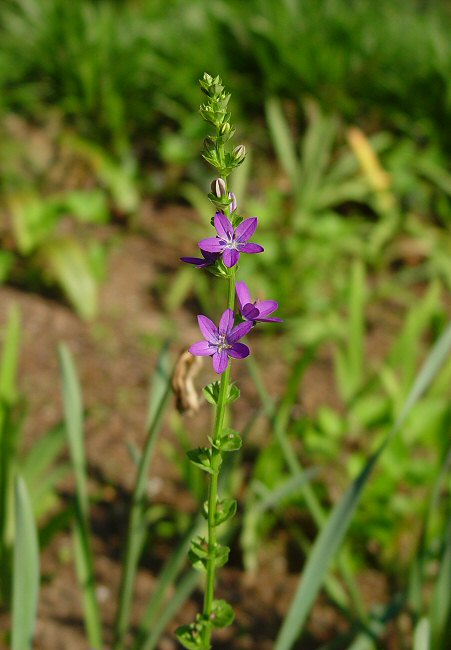Triodanis perfoliata (L.) Nieuwl.
Clasping Venus' Looking Glass

Native
CC = 2
CW = 3
MOC = 86
© DETenaglia
Triodanis perfoliata (L.) Nieuwl.Clasping Venus' Looking Glass | |
 |
Native CC = 2 CW = 3 MOC = 86 |
© DETenaglia |
|
Family - Campanulaceae Habit - Taprooted annual forb, with milky sap. Stems - Ascending to erect, to 80 cm, sometimes from a spreading base, angled, often short-hairy along the angles, sometimes roughened with minute, recurved hairs toward the tip.
Leaves - Basal and alternate, simple. Basal leaves broadly elliptic to broadly ovate, angled or tapered to a sessile or short-petiolate base, rounded or bluntly pointed at the tip. Stem leaves 5-20 mm long, 4-20 mm wide, mostly as long as wide or slightly wider than long (the uppermost ones sometimes slightly narrower), broadly ovate to somewhat kidney-shaped, sessile, rounded to cordate and clasping the stem, rounded to bluntly pointed at the tip, the margins finely and bluntly to sharply toothed, the upper surface glabrous or nearly so, the undersurface finely roughened or with relatively soft, short hairs.
Inflorescence - Flowers axillary, 1-3 per node at most nodes of the stem, mostly cleistogamous, but chasmogamous flowers usually 1 per node along the upper 1/3-2/3 of the stem.
Flowers - Chasmogamous (normal) flowers: Calyces with the tube 3-5 mm long, usually appearing slightly inflated, the lobes 4-9 mm long, narrowly triangular to lanceolate. Corollas purplish blue to purple, rarely with white streaks or entirely white, the lobes 4-7 mm long, 2-3 mm wide. Cleistogamous flowers with the calyx 3- or 4-lobed, the lobes 2-3 mm long, narrowly triangular, the corolla reduced to short flaps of tissue, the stamens and style reduced and nonfunctional.
Fruits - All similar in size and shape, straight and strongly ascending, 5-10 mm long, 2-3 mm wide, the (usually) 3 pores 1.3-2.0 mm long, elliptic, positioned near or below the midpoint of the fruit. Seeds 0.4-0.7 mm long, elliptic to broadly oblong-elliptic, slightly flattened (relatively plump), the surface minutely wrinkled or tuberculate, dull or only slightly shiny, rarely smooth and shinier.
Flowering - April - June. Habitat - Prairies, glades, bluffs, forest openings, marshes, lake margins, streambanks, fields, pastures, railroads, roadsides, and open, disturbed areas. Origin - Native to the U.S. Lookalikes - Other species of Triodanis. Other info. - This small but pretty species is common throughout Missouri, and is found from coast to coast across the continental U.S. It is easily recognized by its purple flowers and clasping leaves, but looks are sometimes deceptive. There are five species of Triodanis in Missouri and some of these can appear quite similar. There is a disturbing degree of variation in the literature regarding proper diagnostic traits, but most authors agree that the position and shape of the fruit pore (the dehiscence aperture) in T. perfoliata is oval (not a narrow slit) and positioned near the middle of the fruit. In immature fruits this can be difficult to discern, as the pore is not yet open, but close examination will usually reveal a thin spot on the fruit where the pore will eventually appear (see photo above for an example of this). The very wide and strongly clasping leaves are another important trait. Photographs taken in the Ozark Scenic Riverways, Shannon County, MO., 5-24-03, and in Auburn, AL., 5-6-05 (DETenaglia); also at Shaw Nature Reserve, Franklin County, MO, 6-5-2015 and 5-21-2007, Weldon Spring Conservation Area, St. Charles County, MO, 5-22-2015, and near Labadie, Franklin County, MO, 5-25-2021 (SRTurner). |